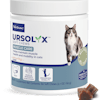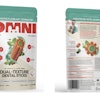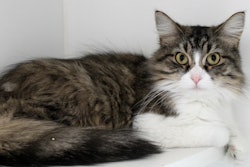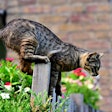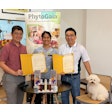
Human don’t eat much swine pluck, which is a pig’s heart, trachea, esophagus and lungs. Like many livestock byproducts, swine pluck contains nutrients that would go to waste if not fed to pets. However, byproducts, or co-products, have been demonized by some pet food marketers and consumer advocates. Despite this, researchers continue to find ways to make use of as much of an animal as possible by making pet food from by-products and thereby reducing waste. For example, Kristian Almendares-Sánchez, a student at Zamorano Pan-American Agricultural School in central Honduras, conducted research on how to use swine pluck as the main ingredient for a dog jerky treat.
The researcher ground raw swine pluck and mixed it with different concentrations (0.5, 0.75, 1%) of guar gum. The guar gum provided structure to the recipe. The mixture was extruded into jerky strips and refrigerated overnight. After refrigeration, the jerky strips were dehydrated for 6 hours. The researcher determined water activity, pH, cook loss and hardness. PH, water activity and hardness values were higher in concentrations of 0.75 and 1% of guar gum. The samples were lower in cooking loss analysis in comparison to a control treatment with no guar gum. The formulation with 0.75% guar gum resulted in a high crude fat of 27.6% and a protein content of 53.6%.
“The minimal process of co-products combined with a structure-forming agent provides a high-value attractive option for both the meat processing industry and pet food industry,” Almendares-Sánchez wrote.
Sustainability of byproducts as pet food ingredients
Traditionally, human food byproducts have served as ingredients in pet food and livestock feed. Despite rare but high publicity problems, such as pentobarbital in pet food, co-products make safe, nutritious ingredients in pet foods. However, marketing claims by some pet food companies disparage byproducts. While the premiumization of pet food drives value growth in sales, it may also increase the amount of resources needed to produce pet foods, while wasting the potential of human food stream leftovers.
Part of people’s resistance to by-products in pet foods comes down to semantics. While environmentally conscious consumers welcome upcycled ingredients, they avoid co-products. However, by-products fit the definition of upcycled ingredients. In a 2021 paper in the journal Foods, scientists proposed defining upcycled ingredients as environmentally friendly foods containing safe ingredients that otherwise would not have gone to human consumption, including damaged food produce, by-products and scraps from food preparation.
In the past few years, upcycling has increased in popularity for human and pet foods.
Some examples of upcycling include:
- Eggshell powder from liquid egg production
- Minced lobster and shell from tail/claw processing
- Apple, blueberry or cranberry residuals after juicing
- Pumpkin’s post-processing leftovers
- Cheese powder from ends and irregulars rescued during cheese production
- Brussel sprout leaves and off-sized pieces
While upcycling has grown in popularity, the stigmatization of by-products has continued in pet food marketing. While upcycled pet food ingredients include by-products, pet owners may tend to think of them as separate and distinct. Renderers and others tried using the term co-products to rebrand by-products, but that name didn’t take off or have the popular cachet of upcycled.
Upcycling has been touted as a means to reduce food waste and thereby fight both human hunger and climate change. Meanwhile, by-products tend to be villainized as low quality and not fit for fur babies. Numerous pet foods advertise themselves as having no by-products. While there isn’t a real distinction between by-products and upcycled ingredients, pet owners don’t think of them as the same. The negative repercussion of this is that pet owners increasingly reject by-products, while those same people demand sustainable pet foods.
“Transparency of food manufacturing processes is lacking so consumers are generally unaware that millions of pounds of by-products each year are discarded,” Crone said. “These by-products yet hold an incredible amount of nutrition. Consumers, however, are increasingly becoming more aware of how their food is produced and how food is wasted. Innova Market Research found that 62% of consumers are willing to pay more for food and beverage products that are dedicated to stopping food waste.”
Salmon by-product rendering into pet food ingredients
Especially in the case of meat, feeding pets the same food as people reduces the human food supply while letting edible tissues, like hearts, go to waste. What’s more, the idea of what human-grade is has changed over time. Many portions of meat that humans reject now were once welcomed on the table (or at least in a sausage). On the other hand, delicacies like lobster were once considered low-class and fed to prisoners in New England, while Europeans thought of potatoes as livestock feed. The distinction between human food and pet food blurs in modern food processing facilities.
In Chile in 2022, I toured a salmon processing plant and a rendering facility. That salmon plant was cleaner than some microbiology labs that I’ve worked in. Every worker wore protective clothing from head to toe, more to protect the meat from microbes hitching a ride on them as vice versa. At the processing plant, one of the managers took a salmon skeleton off the line. The rest of the fish was destined for an American supermarket. The skeleton and bits of flesh clinging to the bones would be rendered into meals and other products for use in pet food and aquaculture. The plant manager picked a bit of the meat off the bones and ate it himself, sashimi style. That salmon was human-grade in marketing parlance, but couldn’t be taken off the bones economically so it had to be rendered.
After seeing how salmon were processed into fillets, I toured a rendering plant where the remnants of the fish became salmon meal. Much of that meal would be exported as a pet food ingredient in the United States.
“We’re essentially a recycling plant,” Benjamin Izquierdo, commercial manager at salmon rendering facility Pesquera La Portada, told Petfood Industry during the tour. Even the liquid waste from the plant gets reused. The plant installed seven worm farms where red wigglers (Eisenia fetida) devour the processed liquid waste after it is sprayed into their beds. These natural filters protect local watersheds while producing fertilizer used in local reforestation projects.
Izquierdo noted that past aquaculture practices gave salmon farming a bad reputation to some. However, current activities in Chile aim to minimize environmental effects by preventing excessive pollution from fish feed and feces, while tracking the movement of salmon aquaculture operations to prevent escapes into the wild. However, as in the pet food industry, negative public perceptions can be difficult to counteract.
Rendering the by-products from those salmon into pet food ingredients reduces food waste and makes more efficient use of the resources needed to produce human foods. Rebranding these products as upcycled could aid acceptance by pet owners. While dogs’ ancient ancestors were wolves, for the past 10,000 years or so dogs’ forebears devoured human refuse and handouts during domestication. While nutritionally balanced dog diets have replaced trash middens and leftovers, modern canines can still fulfill their primeval passion for making sure no food goes to waste.
Unused human food items seem a natural fit for pet food. Dogs and cats have eaten what we didn’t since before Stonehenge’s grand opening. Kids are still prone to reducing food waste by feeding unwanted portions to the dog. Like a kid at the dinner table, the human food system often rejects foods it thinks look funny. Misfit fruits and veggies may not fit through processing machines or people won't buy them fresh, for example. However, using crooked carrots and twisted ‘taters to make pet food doesn’t just fulfill the dinner-time adage of waste-not-want-not. Reducing food loss by turning it into pet food ingredients fights the global threat of a destabilized climate.
Food waste, climate change and pet food solutions
Agriculture affects the atmosphere in various ways. From producing fertilizer to flatulent cows to trucking veggies to market, the food system releases carbon dioxide, methane and other heat-trapping gases. While upcycling agricultural products doesn’t solve this problem, it does mean that pollution wasn’t produced in vain. Along with greenhouse gases, upcycling reduces waste of wildlife habitat lost to farmland and water diverted to irrigation.
Food waste equates to tremendous amounts of pointless pollution and wasted resources. The World Resources Institute report “Creating a Sustainable Food Future” presented data that food waste corresponds to 8% of annual greenhouse gas emissions worldwide, or the equivalent of 4.4 gigatons of carbon dioxide. If it were a country, food waste would be the third-largest contributor of greenhouse gases on the planet. To grow all that unused food, farmers use a land area larger than China and consume a quarter of irrigation water. Overall, approximately 24% of food is lost or wasted between production and consumption.
Pet food and treats can use that otherwise wasted food, or at least some of it. Food rescued from waste could replace at least part of a pet food company's need for ingredients. That could reduce the demand from pet food companies for some raw materials or reduce competition between human and pet food streams.
World Resources Institute analysts estimated that cereals, including grains, make up 53% of food loss and waste by caloric content. Fruits and vegetables comprised 44% by weight of lost or wasted food. In total, 1.5 quadrillion kilocalories were lost or wasted in 2009, from 1.3 billion tons of food.
Upcycled pet food ingredient certification requirements
The Upcycled Food Association enumerated requirements for a certification program. To obtain a certification from the Upcycled Food Association, a pet food ingredient supplier needs to meet these criteria:
- Documentation that inputs were previously destined for a food waste destination.
- Documentation such as a Bills of Lading, proof of segregation, identification of supply chain GHGE sources and other pertinent information related to supply chain and production practices.
- Documentation of the percentage of upcycled ingredients by weight and the tonnage diverted as a result of yearly production.
- Compliance with all applicable regulations for the process, production, intended use, and market destination outside the UCP purview such as AAFCO Standards.

